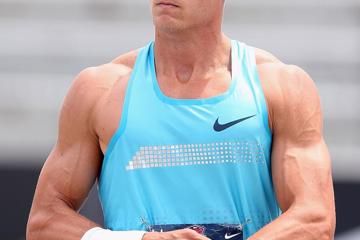Dutch heptathlete Nadine Broersen (© Getty Images)
Life has changed a lot for Nadine Broersen after winning the gold medal in the pentathlon at the IAAF World Indoor Championships in Sopot.
The 23-year-old was already well known to Dutch athletics fans, but becoming the third world indoor champion from the Netherlands made her part of an exclusive club, joining the likes of 1989 world indoor 3000m champion Elly van Hulst and 1987 and 1989 world indoor 60m champion Nelli Cooman.
“I got a lot of media attention and a big reaction from friends and athletics fans,” said Broersen. “In the first few days after winning gold, I didn’t even open my Facebook page, because there were so many messages that I couldn’t read them all.
“I know well enough that it is all part of the life of a successful professional athlete, but I’m not used to it and in fact I’m rather shy and not a person who likes to be in the spotlight.
“But I must also admit that all the recognition I received is good for my self-confidence. This was really a step forward in my career as a sportswoman. I can now dare to tell myself that I can achieve something in athletics. That is one of the most important changes in my life in the past couple of years and I have to thank my coach Ronald Vetter for that too, because he always believes in me.”
Broersen’s golden performance in Sopot was a special one. She scored a national record of 4830, 29 points more than Karin Ruckstuhl scored when winning the bronze medal at the 2007 European Indoor Championships.
Ruckstuhl has always been an inspiration for Broersen. “It’s just unfortunate that I never had the opportunity to compete against her directly or to train together,” said Broersen. “When I became a top athlete around 2009, she had to retire from the sport due to injuries.”
Another significant result from Sopot was Broersen’s Dutch indoor record of 1.93m in the high jump, adding to the outdoor record of 1.90m she set in 2013.
“For me, it wasn’t a big surprise that the high jump went very well in Sopot,” said Broersen. “Due to a slight problem in my knee, I had to reduce the jumping for some time. But for more than a year now I can do my high jump training every week.
“In general I can say that I’m blessed with a strong body. I might have a little pain sometimes, which is normal when you train hard. But I haven’t missed many training sessions in recent years.”
Discovery of Broersen’s all-round talent
Broersen is a member of the Dutch national combined events squad and trains at the Olympic Training centre in Papendal in the eastern part of the Netherlands.
“She came here in 2009, but not as a heptathlete,” says Vetters, her coach. “She was good at hurdling, the high jump and the javelin. For our talent coach Bart Bennema, these are the three key disciplines for a good heptathlete, so we offered her the chance to come.”
In 2009 she was fifth at the European Junior Championships and two years later she finished ninth at the European Under-23 Championships. But in 2012 she made a big leap forward and qualified for the Olympic Games sooner than expected.
At the age of 22, she finished 12th in London with a PB of 6319, almost 400 points better than her PB before that year.
“A lot of athletes and coaches make the mistake of adding more and more volume to a training programme after such a big performance,” says Vetter. “But from what I had heard seen from other coaches, I knew that that’s one of the biggest mistakes you can make. Nadine was only young and we had to avoid an overload, so I added just a few extras to the programme and reduced other aspects.”
Further breakthrough prevented by misfortune
“My fitness improved and I grew stronger, but unfortunately I couldn’t prove it at the big championships,” said Broersen. At the 2013 European Indoor Championships she was in a medal position, but was disqualified in the 800m as she stepped over the line in a race where athletes had to share a lane.
But the biggest disappointment came at the IAAF World Championships in Moscow, where she tripped on the last hurdle, slowing her down by more than a second and costing her valuable points. “But it was a great achievement that she was able to pull herself together in the following six disciplines, finishing with 6224,” said Vetter.
Had it not been for the stumble in the hurdles, she most likely would have broken the PB of 6345 she set earlier in the year at the Hypo-Meeting when finishing a close second to world silver medallist Brianne Theisen-Eaton and ahead of world bronze medallist Dafne Schippers.
All three athletes will return to the IAAF Combined Events Challenge meeting in Gotzis this weekend in what will be their first encounter with one another since last year’s World Championships.
Targets for 2014
Following her pentathlon breakthrough in Sopot, Broersen now has new goals in the heptathlon this summer.
“Javelin is one of my strongest disciplines as I have a PB of 54.97m,” she says. “But in the 200m I hope I finally can make the progress that I’ve been longing for. In Moscow I ran a PB of 25.01, but I really want to go under 25 seconds this year.”
Vetter concurs. “The 200m will no doubt be the main focus this year,” he says.
This weekend’s competition in Gotzis will be her first opportunity to improve on her PB, and another big goal will be the European Championships in Zurich in August.
“I know the expectations will be high from everyone here in Holland,” says Broersen. “But ultimately I’m the only one who can really put pressure on me.”
Cors van den Brink for the IAAF






